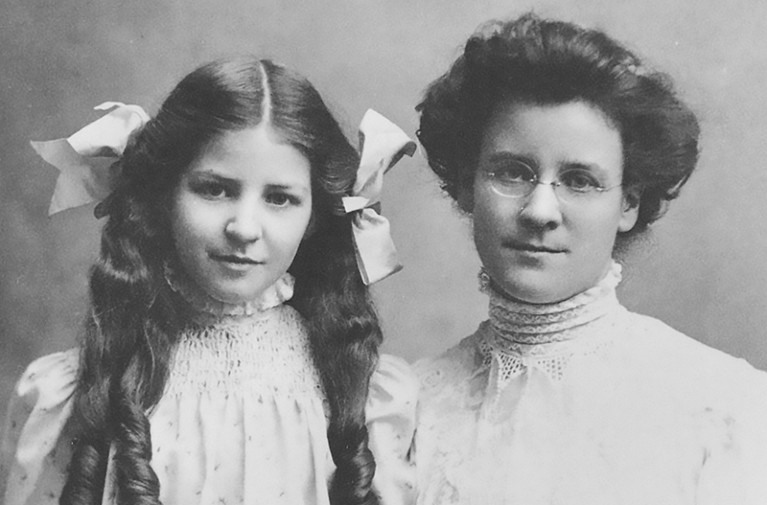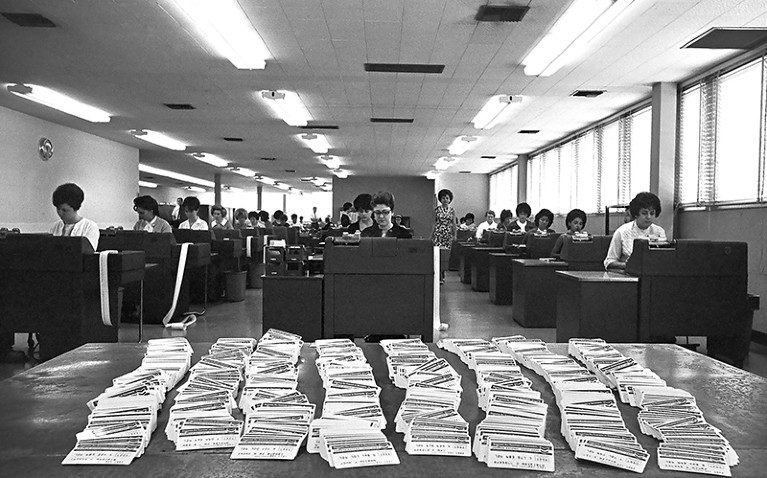
Isabel Briggs Myers (left) and her mother, Katharine Cook Briggs (right).Credit: Myers & Briggs Foundation
The Personality Brokers: The Strange History of Myers-Briggs and the Birth of Personality Testing Merve Emre Doubleday (2018)
Most of us have, at some point, completed a formal personality test. Chances are it was the Myers-Briggs Type Indicator (MBTI). Introduced by Isabel Briggs Myers in 1943, it asks 93 questions, such as, “If you were a teacher, would you rather teach (a) Fact courses or (b) Courses involving theory?” On the basis of their answers, an individual’s ‘personality type’ is plotted along four axes: extraversion (E) to introversion (I); sensing (S) to intuition (N); thinking (T) to feeling (F); and judging (J) to perceiving (P). The results, proponents claim, allow people to understand themselves and others in terms of a four-letter label: I may be an ESTJ (a ‘supervisor type’); you an INTP (an ‘architect type’).
By conventional psychometric criteria, the MBTI is highly suspect. In failing to measure what it purports to measure, it has low validity and in failing to elicit consistent responses across testing contexts, it has low reliability and little predictive power. But The Personality Brokers, by literature scholar Merve Emre, does not debate the limitations of the MBTI — a path many have trodden. Instead, Emre’s careful investigations of the tool’s bizarre origins and alarming impact weave a compelling narrative that recounts the rise of twentieth-century managerial and personnel-theory science with the gritty wistfulness of a John Steinbeck novel.
Isabel Briggs Myers (1897–1980) was an autodidact who eschewed formal psychological methods of test development and validation. She became interested in personology, as she called it, largely as a result of an obsession her mother, Katharine Cook Briggs (1875–1968), had with the ideas of psychoanalyst Carl Jung. Emre charts the women’s competitive relationship and expanding ambitions with sensitivity and skill.
Initially Cook Briggs wanted to make a landmark contribution to the practice of child-rearing. In popular-magazine articles, she presented Isabel as a triumph of an “obedience-creativity” regime. In this model, kindness, warmth and play were won only after authoritarian orders to study and work had been complied with. Before reading Briggs Myers bedtime stories, Cook Briggs required her to complete a demanding programme of study. By her early 30s, Briggs Myers was an accomplished polymath and award-winning writer of formulaic but engaging detective fiction.
These ventures paved the way for both women’s fervent interest in personality. Cook Briggs hoped to make Jung’s obscure writings accessible to the world by cataloguing the character of everyone she met on index cards. Briggs Myers formalized her mother’s project into the MBTI, after losing the proceeds of her novels in the 1930s economic crash.
A breakthrough came at the end of the war, when the test was embraced by the Office of Strategic Services (a short-lived forerunner to the Central Intelligence Agency) as a tool for assigning intelligence operatives in newly liberated Europe. Briggs Myers recognized and promoted the tool’s attractiveness to those responsible for sorting students into suitable fields and employees into jobs. By the mid-1950s, she had persuaded more than 45 medical schools to use it for admissions and clients such as General Electric, Standard Oil and Bell Laboratories to inform recruitment and promotion decisions. Today, the MBTI is deployed widely, although its uses remain largely corporate: building a team or recruiting for an executive-training programme.
Emre’s account of the emergence and appeal of the MBTI is nuanced and non-judgemental. She imparts fascinating details of two willful women making their way in a sexist — and racist — corporate landscape (observing that the MBTI’s questions spoke to a middle-class world that was then largely off-limits to people of colour). She excels in showing how the MBTI’s success rests on its facile summary of a seemingly unfathomable subject: the self. Moreover, because it produces profiles that are always positive, it proves perenially palatable to consumers.

Standard Oil began using the MBTI tool during the 1950s for recruitment and promotion.Credit: Ted Streshinsky/Corbis via Getty
Hence, as Emre explains, the MBTI also emerged as the perfect device for the creation of “The Organization Man”, as heralded by William H. Whyte in his 1956 best-selling text of the same name. Specifically, the test required employees to submit to the rigorous regimes of corporate life, and fetishized the need for them to be “individuals”. This fed into hire-and-fire managerial prerogatives while also extinguishing the appetite for collective resistance. For all its light and liberal pretensions, the MBTI thus has a dark and deeply conservative heart. This is a tool of status quo, not social change. Indeed, its political functions are plain to see, precisely because the research that underpins it is so poor.
Emre’s engagement with some matters of psychology is less assured. She might have done more to help readers understand how the Myers-Briggs instrument and industry relates to, and departs from, theories and methodologies of contemporary psychological science. She should have avoided name-dropping psychologists, such as Stanley Milgram and Philip Zimbardo, whose work is neither relevant nor helpful to her cause.
And, notwithstanding the blurb’s claims, if you want to know “what makes you you”, look elsewhere — not least, to discover up-to-date research pointing to the dynamic nature of personality and to its collective, rather than purely personal dimensions. Indeed, using the MBTI to unlock the mysteries of the self is akin to trying to understand the Stone Age by watching The Flintstones.
But Emre’s goal is not to understand the self. Rather, it is to explore two particular selves. This is a story of two remarkable women who founded an enormously successful commercial empire, which has significantly framed the conversation about the contours of personality, as understood by millions of Westerners today. As Emre shows convincingly, the fact that the premises of this conversation are so flimsy makes the examination of its origins and impact all the more interesting, more important — and more disturbing.






